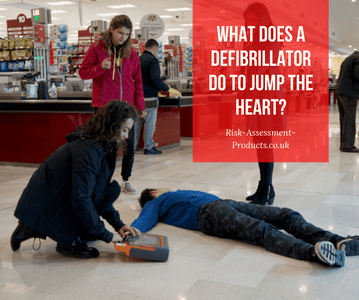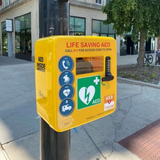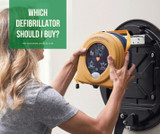What does a defibrillator do to jump the heart?
A defibrillator analyses a heart that has gone into sudden cardiac arrest. A sudden cardiac arrest occurs when there is an electrical fault with the heart. This causes the victim to fall unconscious and stop breathing.
To rectify this irregular beating of the heart, defibrillators send an electrical shock to the heart at a rate of 300 joules, this is known as electrical cardio-version. Electrical cardio-versions are delivered when someone is suffering a sudden cardiac arrest. Sudden cardiac arrests can happen to anyone at anytime and if intervention is not put in place, the chances of survival are unfortunately really slim.
When someone suffers a sudden cardiac arrest, it is important to act as quickly as possible. Call the emergency services, begin CPR and locate your nearest defibrillator A defibrillator is what can make the difference between life and death for a sudden cardiac arrest patient.
Easy to follow instructions mean that defibrillators are straightforward to use. Most come with both visual and audio guides so you know exactly how to use one when in an emergency. Firstly, you will need to place the electrode pads on the patients bare chest. This enables the defibrillator to scan the chest which will then determine whether a shock is required or not.
If you have an automatic defibrillator, it will administer the shock for you and if you have a semi-automatic defibrillator, it will require you to push a button to then administer the shock. A defibrillator will never deliver a shock when one is not required.
Defibrillators are really clever pieces of medical equipment. They will store the data from the patients heart so that medical professionals can see the shock history and whether it has worked. Thankfully, defibrillators have a success rate of as high as 90% if used within the first minute.
What causes a sudden cardiac arrest?
A healthy heart has a group of cardiac muscle cells called the cardiac conduction system. These muscles send an electrical signal to the heart which cause it to beat. The cardiac conduction system begins working in the right atrium, in an upper chamber where the signal is then sent down to the ventricles in the lower chambers. The signal that is sent through the heart by the cardiac conduction system causes the heart to contract in an organised rhythm.
If this signal is interrupted, the heart starts to beat fast and chambers have less time to fill with blood between each beat. This means the body receives less blood supply and is why a patient falls ill. Defibrillators help to rectify this by delivering a shock so that the heart can resume it’s normal beating pattern.
Recent Posts
-
Empowering Communities: The Lifesaving Impact of CPR on Restart a Heart Day
Every year, on and around October 16th, an important event takes place - Restart a Heart Day. This a …16th Oct 2023 -
Which home defibrillator?
80% of all out of hospital cardiac arrests occur at home. Defibrillators are often available in loca …4th Dec 2022 -
Which defibrillator should I buy?
There are many defibrillators available on the market and it can become overwhelming knowing which o …4th Nov 2022




